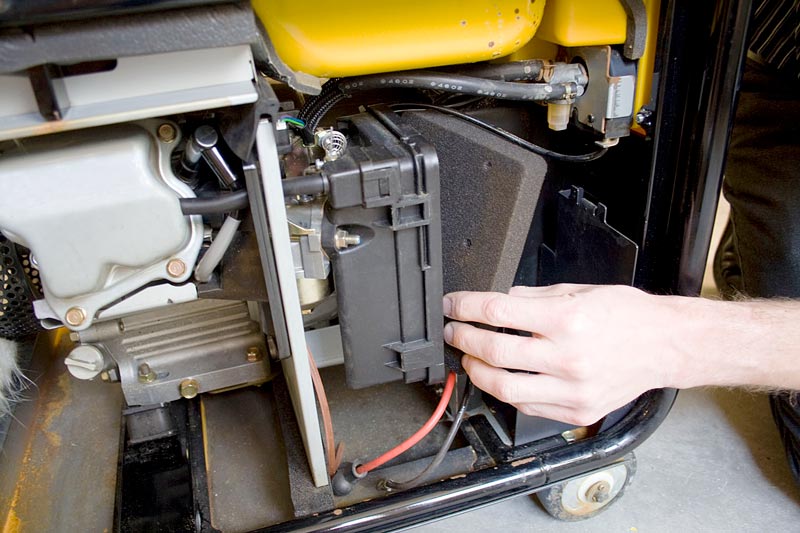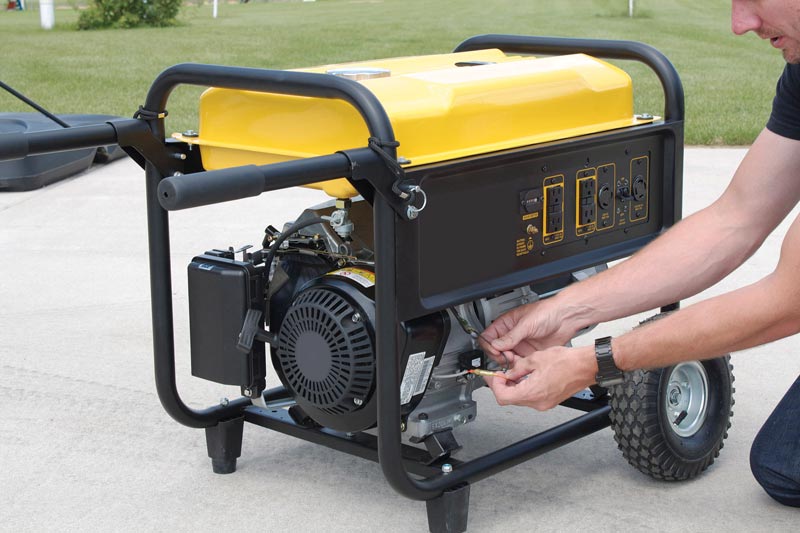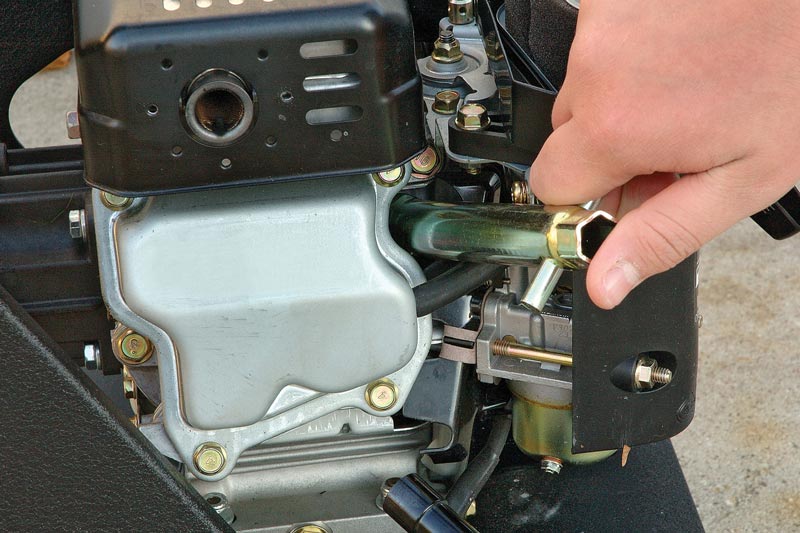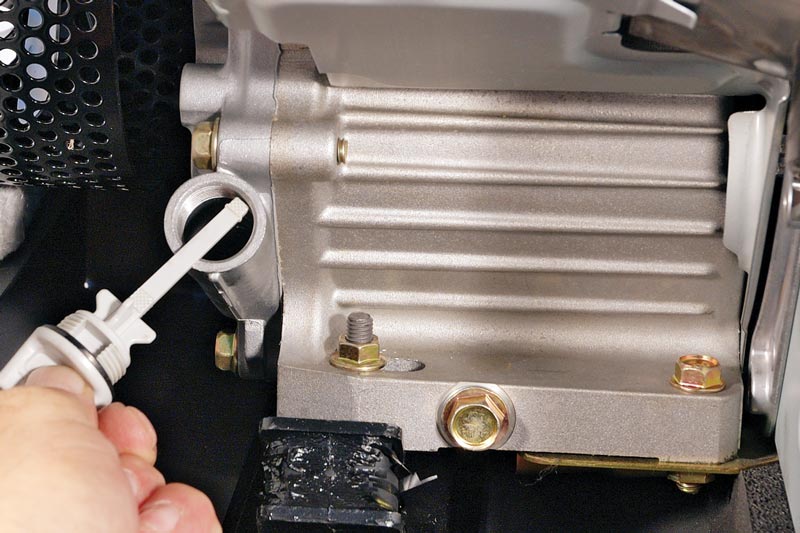
Replace a dirty, shrunken or torn air filter to ensure an engine gets enough air to run efficiently. Photos courtesy of Subaru Industrial Power
Power equipment such as snowblowers, power washers, generators and lawn mowers are built to do a specific job, and in most cases, they do it well. But when a piece of equipment doesn’t perform as it should — or not at all — it not only impacts how safely, efficiently and quickly you can do your job, but it can also impact your bottom line.
That’s why proper engine maintenance and on- and off-season preparation are crucial. Without this attention, the engine’s performance could be diminished and its life span drastically reduced, which means you’ll be spending more time and money on repairs and replacements. And when your equipment is out of commission, it also means projects on the golf course start running behind schedule.
But make regular engine maintenance a habit, and the reverse is true: Machines run at peak performance, engines last longer, and the potential for injuries and costly damage to components is reduced.
Get fired up
Before you fire up an engine at the start of a season, make sure it’s ready.
Inspect the engine on a stable, flat surface in a well-ventilated area away from ignition sources. Check all components to make sure they are clean, in good condition and firmly in place, including the spark plugs, muffler and fuel cap. Be sure wires and fuel hoses are intact and in good condition. Damaged fuel hoses can allow fuel to escape, which increases the risk of fire when they’re near a hot engine.
Tighten or replace bolts that may have become loose or damaged via vibrations or fluctuations in temperature. Operating equipment with loose or broken fasteners could result in serious damage to the engine and operator.
Clean air is crucial to the engine’s efficiency. To make sure it’s getting enough, check the air filter and replace it if it’s dirty. Also replace a foam filter that has torn or shrunk so that contaminants don’t get into the engine.
Even more vital to engine efficiency is fuel. If it hasn’t been treated with a stabilizer, it degrades and becomes stale. Stale fuel causes residue buildup that can plug the carburetor and prevent the engine from starting. To avoid this entirely, always replace old fuel.
Oil that hasn’t been changed regularly can become thick and gummy and increase the risk of corrosion, which can keep the engine from running efficiently. Replace it with oil that has the proper weight as specified in the owner’s manual.

Verify that all wires are intact and in good condition.
If the engine has accumulated dirt and dust while in storage, a thorough cleaning will get rid of buildup and keep it running efficiently. Make sure the engine — and the recoil starter, if the engine is equipped with one — is free of dirt, grass and other debris. Also ensure the cooling fins under the shroud are clean and free of obstructions that could cause the head area to overheat. You can use an air hose to blow off the engine, or you can wipe it down with a dry rag. Avoid washing it with a hose or pressure washer, which could force water into the engine and cause corrosion.
Now you’re ready to roll, push or pull into the season.
Engine troubleshooting: What to do when
It’s not uncommon to occasionally experience problems with starting or lost power. When this happens, always begin by inspecting the four things an engine needs to operate: fuel, oil, spark and compression.
Always make sure there is enough fuel in the tank and that the fuel valve — if the engine is equipped with one — is open and in the “on” position. Also ensure the engine has enough oil and that the ignition is turned on. While these are obvious concerns, checking them first can save you a lot of time and hassle.
In addition, check that enough fuel is making its way to the engine. Choke and pull the starter five or six times, then remove the spark plug and see if the electrode is wet. A dry electrode indicates that not enough fuel is being supplied to the engine, which can be a result of several issues and should be inspected by a repair shop.
An improperly gapped or loose spark plug could also be the culprit behind an engine that doesn’t start. Inspect it to make sure the porcelain and electrodes are not damaged and that it’s properly gapped so it can fire efficiently. Refer to the manufacturers manual for the recommended gap distance. Tighten the spark plug firmly, but don’t make it too snug, as this can damage the threads in the cylinder head.

Making sure the spark plug is properly gapped and producing a spark is one way to troubleshoot an engine that won’t start.
You should also check to ensure the spark plug is producing a spark. To test it, take the cap off and remove the spark plug from the engine. Insert it back into the cap and place the metal base against the engine, which will ground the current as you test. Confirm the ignition is in the “on” position and slowly turn the engine over. If the plug does not produce a spark, then it should be replaced.
Test the engine’s compression by slowly turning it over but not starting it. If you can do this with little to no resistance, it’s an indication of a compression problem, and the engine should be taken to a repair shop.
If the unit has a battery, the terminals need to be clean and free of corrosion so there are good connections. If they need to be cleaned, wear gloves to disconnect the cables and remove the battery. Use a stiff wire bristle brush to remove any residue. If the unit has a fuse, also check to make sure it hasn’t burned out.
If your engine still doesn’t start, it’s time to visit the repair shop.
On the other hand, if your engine starts but operates with less power than normal, there’s still more you can do yourself. Make sure the air filter is clean and unobstructed. If the fuel has a distinct odor (similar to varnish), it’s likely stale and could have caused residue buildup that plugged the carburetor. If so, you’ll need to replace the fuel and clean the carburetor. Typically, you can use carburetor cleaner from most automotive stores.
Anytime issues arise, it’s a good idea to go to the manufacturer’s website — many of them offer how-to videos on troubleshooting common issues — but what’s even more critical than troubleshooting is heading off those unexpected problems with regular maintenance.
Keep it going
Before every startup, inspect the unit for damage, and make sure fluids are clean and that they are at the appropriate levels.
Keep your eyes, ears and nose open when operating power equipment. Excessive vibration or noise could indicate loose fasteners or other serious problems with the engine, and a strong smell could be a sign of a potentially hazardous leak. If you sense something is out of the ordinary, stop the machine immediately and allow it to cool. Place it on a flat, level surface in a well-ventilated area and inspect it thoroughly.

Change oil regularly to prevent it from becoming thick and gummy.
It’s also important to regularly change the oil to prevent corrosion. Periodically inspect the air filter and fasteners that could have loosened during use.
Engines that remain stationary during operation, such as those found in generators, must be placed in a well-ventilated area far from doors and vents with the exhaust facing away from walls. This prevents the engine from overheating and reduces the risk of carbon monoxide poisoning. It’s also a good idea to close the windows and doors of nearby structures when the engine is running, to keep out fumes.
Golf course equipment storage
Most equipment is not operated year-round, so it’s vital to prepare the engine for long-term storage. These simple steps will ensure it doesn’t become damaged by rust or corrosion, and will make it easier to get the machine up and running next season.
As mentioned before, stale fuel has the potential to plug the carburetor. To eliminate the risk of issues next season, clear the lines by draining the fuel tank and running the engine dry.
Another option is to add fuel stabilizer, which keeps the fuel from going stale and prevents corrosion and rust within the tank. First, fill the tank with fresh fuel, which leaves no room for condensation that can lead to rust and fuel contamination. Next, add the fuel stabilizer. Refer to the instructions on the bottle for the recommended amount. Start the engine and allow it to run briefly until the stabilizer has cycled through the system. Keep in mind that stabilizer is only good for about one year. If you will be storing the engine for longer than that, you should drain the fuel.
It’s also a good idea to lubricate the system to inhibit rust formation. Remove the spark plug and spray fogging oil or use a dropper to place one tablespoon of oil in the spark plug hole. Distribute the oil throughout the combustion chamber by pulling the recoil rope until you’ve reached top dead center, which means the piston is at its highest point. This ensures the intake and the exhaust valves are closed, and the potential for air, water or pests to enter is eliminated. Clean or change the air filter if necessary; doing it now means a quicker startup next season.
Replace the engine’s oil. In addition to acid buildup that can corrode the engine’s internal components — such as the crankshaft and connecting rods — water and particles collect in the oil during normal use. Leaving those contaminates in the oil during storage also leads to corrosion.
Cover your equipment with plastic to keep out dust and debris. Store it on a level surface in a well-ventilated area away from furnaces, stoves, water heaters, motors or anything else that has an ignition source or could produce a spark. Moisture promotes rust and corrosion, so keep the equipment in a dry area with low humidity.
With the right preparation, your equipment will withstand the effects of long-term storage. Whether it’s a walk-behind mower, snowblower, generator, power washer or another piece of power equipment, following these guidelines and the manufacturers manual for engine maintenance and troubleshooting will keep it in top shape so it’s ready when you need it.
Dale Gabrielse is in sales and marketing support for Subaru’s Industrial Power Products division.